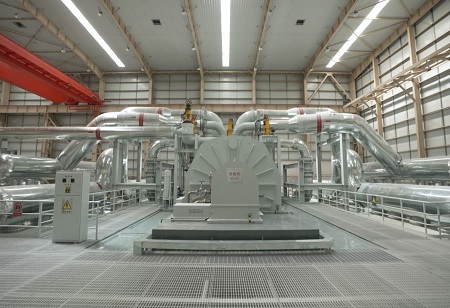
China Unveils World's Largest Compressed Air Energy Storage Project

 ZCGN, a Chinese developer, has finished building a 300 MW compressed air energy storage (CAES) facility in Feicheng, located in China's Shandong province. The company announced that this storage plant stands as the largest CAES system globally. Prior to this, the largest CAES facility was a 100 MW project inaugurated in October 2022 by the Institute of Engineering Thermophysics of the Chinese Academy of Sciences, situated in China's Hebei province.
ZCGN, a Chinese developer, has finished building a 300 MW compressed air energy storage (CAES) facility in Feicheng, located in China's Shandong province. The company announced that this storage plant stands as the largest CAES system globally. Prior to this, the largest CAES facility was a 100 MW project inaugurated in October 2022 by the Institute of Engineering Thermophysics of the Chinese Academy of Sciences, situated in China's Hebei province.
ZCGN has announced the completion of its groundbreaking system, comprising a multi-stage wide-load compressor and high-load turbine expander, alongside cutting-edge technologies such as high-efficiency supercritical heat exchangers and integrated control systems. The company asserted that this facility, touted to be 30% more cost-effective compared to the 100 MW project erected by the Institute of Engineering Thermophysics, boasts an impressive overall efficiency rating of 72%.
With a staggering energy storage capacity of 300 MW/1,800 MWh and spanning across approximately 100,000 m2, the $207.8 million facility has been unveiled. ZCGN reports that it can sustain uninterrupted power discharge for up to six hours, guaranteeing electricity provision to an estimated 200,000 to 300,000 households in the local area during peak consumption periods.
The station uses an underground salt cave with wells reaching depths of up to 1,000 meters. The cave boasts a gas storage capacity exceeding 500,000 cubic meters. The facility reportedly generates 600 TWh of electricity annually and is projected to save about 189,000 tons of standard coal consumption. It will also reduce carbon dioxide emissions by approximately 490,000 tons per year.
The investor behind the project has revealed intentions to generate revenue by tapping into various ancillary services and engaging in China's electricity trading market. Projections suggest the project could deliver an internal rate of return on capital of approximately 16.38%, with an estimated payback period of around 7.1 years. Additionally, it is poised to provide crucial power regulation services to the Shandong provincial power grid, encompassing tasks such as peak shaving, frequency stabilization, phase shifting, and standby power supply.

